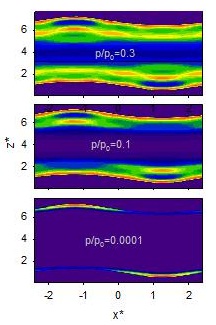 |
 |
PLENARIA 3
Effect of Geometrical Corrugation and Energetical Heterogeneity of Graphene Pore Walls on Gas Adsorption in Nanoporous Carbons
Jacek Jagiello* and James P. Olivier
Micromeritics Instrument Corporation, Norcross, GA 30093, USA.
*Corresponding author email: jacek.jagiello@micromeritics.com
A recently published study [1] reported the atomic-resolution aberration corrected images of two activated carbons derived from different precursors. These images obtained by using scanning transmission electron microscopy (STEM) show clearly that the building blocks of these carbons are wrinkled and curved graphene sheets. The nonhexagonal defect rings of carbon atoms produce the curvature of the graphene sheets. These detailed observations obtained using atomic resolution microscope confirm earlier concepts of graphene based structure of microporous carbons. |
This strong evidence of the existence of curved surfaces in activated carbons motivated us to study the effects of the surface curvature on gas adsorption in carbon pores with corrugated graphene walls. We use the two dimensional non-local density functional theory (2D NLDFT) to calculate adsorption isotherms and the fluid equilibrium density profiles. As an example, Figure 1 shows cross-sectional contours of the fluid density profiles calculated for N2 at 77.3 K in carbon pores with smoothly corrugated graphene walls. It is important to note that the corrugation imposes adsorption energy heterogeneity of the surface. The adsorption energy is higher in concave areas of the surface than in flat or convex areas. As a result, adsorption begins at low pressures in concave parts of the surface and proceeds gradually through flat to convex areas. Important implications of surface energetical heterogeneity are adsorption isotherms that are smoother and have less pronounced monolayer transitions than those calculated for uniform surfaces.
[1] J. Guo, J. R. Morris, Y. Ihm, C. I. Contescu, N. C. Gallego, G. Dusher, S. J. Pennycook, M. F. Chisholm, Small 2012, DOI:10.1002/smll.201200894. |
|
Contactos: saasa@unsl.edu.ar
Página Web: http://infap.unsl.edu.ar/congreso/index.html
